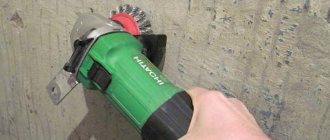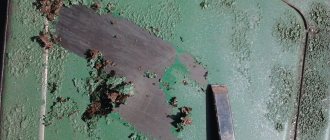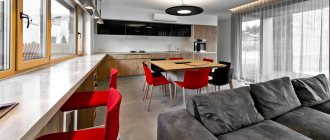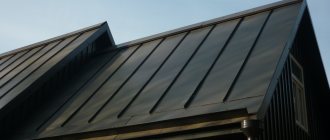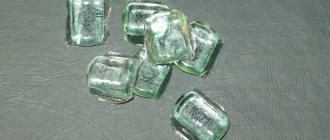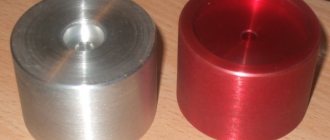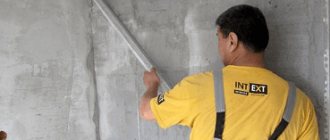The durability of paint and varnish coatings applied to a metal surface largely depends on the thoroughness of the preliminary preparation of the metal surface for painting.
The performance qualities of protective paint and varnish coatings significantly depend on the condition of the metal surface immediately before painting. The condition of surfaces requiring cleaning before painting can vary widely.
Different steel surfaces may have different initial states. Methods for assessing the surface condition of steel structures are established by international standards ISO 8501, 8502, 8503 .
Classification of metal surfaces
Metal surfaces to be cleaned are classified by degree of oxidation according to ISO 8501 and GOST 9.402 .
A – The surface of the metal is almost completely covered with mill scale adhered to the metal. There is almost no rust on the surface.
B – The metal surface has begun to rust, and mill scale begins to peel off from it.
C - A metal surface from which mill scale has almost completely disappeared as a result of corrosion, or from which mill scale can be easily removed. Small corrosion pitting is observed on the metal surface.
D – Metal surface from which mill scale has disappeared as a result of corrosion and on which pitting corrosion is observed over the entire surface.
Video description
Watch the video to get acquainted with the main intricacies of the process:
Important! Application of the next layer begins after the previous one has dried.
When painting with a brush, the tool is immersed in paint to 1/3 of the length of the bristles. The composition is applied to the surface, making movements in one direction. First, a certain amount of paint is applied to the base and then rubbed onto the metal surface.
When using a spray gun, it is possible to maximize painting productivity. Due to the low absorbency of the metal surface, increased demands are placed on the operator’s qualifications in terms of smoothness and speed of movements. The layers are applied in parallel.
Metal surface preparation
Metal surface preparation is one of the main conditions for successful anti-corrosion protection. There are many different conditions of metal surfaces that require cleaning before painting. First of all, this concerns the repair of previously painted surfaces.
The age of the object and its location, the quality of the original surface, the number of defects, the type of previous and future aggressive conditions, the properties of old coatings - all these factors influence the upcoming preparation of the metal surface. When choosing a surface preparation method, the required degree of cleaning and surface roughness should be taken into account.
To achieve the best result, the degree of surface preparation should be selected in accordance with the purpose of protection and the type of paintwork.
The most effective method of mechanical preparation of metal surfaces is abrasive blast cleaning. However, abrasive blasting is the most expensive method of surface preparation.
Abrasive blast cleaning is characterized by the following properties:
- the ability to achieve high productivity;
- different degrees of preparation and surface profiles can be achieved;
- the method is applicable to most types and shapes of surfaces;
- partial removal of individual sections of damaged coating is possible;
- abrasive blasting equipment can be either stationary or mobile.
How to paint metal?
Suitable products are the key to success, so when working with metal bases, this factor plays the most important role.
Universal materials
Painting can be carried out by the following common types of products:
- Epoxy. For the manufacture of such compositions, silicone resins are used, which are supplemented with a hardener. Due to their high toxicity, they are used only for outdoor work. They differ in the complexity of application.
Epoxy paint for metal is a strong and durable coating that provides excellent protection against corrosion. - Oily. A traditional option based on organic matter. Before treatment with this composition, the metal is pre-coated with primer. Due to the toxicity and pungent odor, parts can only be painted with good ventilation.
- Alkyd. They are in constant demand in cases where metal products need to be processed. Suitable for indoor and outdoor events. If the base is well prepared and has no problems, then the composition can be applied without prior priming.
- Acrylic. A modern polymer-based variety. Non-toxicity and ease of application make the material popular. The composition is suitable for painting metal surfaces subject to careful preparation.
- Rubber. Used for outdoor use, excellent for roofs or areas exposed to precipitation.
Rubber paint for metal is often used to finish galvanized roofing.
These solutions are considered classic and are used everywhere. The powder painting method stands out separately. It is complicated in that it requires the use of special equipment and tools.
On a note! When choosing the appropriate option, consumption, toxicity level, required degree of preparation, durability, special properties and cost are also assessed.
Specialized options
To ensure reliability and durability, in some cases special materials are required:
- Compositions used in the presence of rust. They are an epoxy variety with special additives. They create a reliable film, preventing further destruction. They are applied without pre-treatment of the base directly to rusty areas.
Profilux paint combines the properties of a primer, anti-corrosion paint and metal enamel - To prevent corrosion. Such materials provide the surface with additional protection from moisture and oxygen, that is, they do not allow parts to rust.
- Hammer compounds. They form an interesting decorative coating, reminiscent of traces of multiple hammer blows. They have good stability. Various base options are used for production: epoxy, acrylic, alkyd.
- Primer-enamel. A universal type of product that combines primer, corrosion protection and paint.
- Forging mixtures. Their production involves polymer compounds, which gives the coatings excellent wear resistance. Demonstrate good adhesion.
Forging paint Certa Plast - Nitro paint. Sold in cans. It is highly toxic.
There are other types of coloring mixtures - varnish and enamel, which are used in the processing of stoves and other similar products. They belong to heat-resistant materials.
Types of surface preparation
Metal surface preparation can be primary or secondary.
1. Primary (general) surface preparation is the preparation of the entire surface until the steel is exposed;
2. Secondary (local) surface preparation is the preparation of the surface leaving firmly adhered parts of organic and metal coatings.
Primary preparation is carried out to remove mill scale, rust, various contaminants and remnants of old coatings from the metal surface before applying the primer layer. After initial preparation, the entire surface is bare steel.
Scale is a very unreliable substrate, since it has a different expansion coefficient than steel, and therefore, when temperatures change, the brittle layer of scale can peel off (which leads to destruction of the coating).
Secondary preparation is carried out for the purpose of local removal of rust and foreign materials from the surface of the metal coated with a primer or impregnation, before applying an anti-corrosion protective composition.
The choice of processing method for metal painting is influenced by the material of the structure being cleaned, the thickness of the material, dimensions, conditions of the cleaning work, as well as the nature of the foreign inclusions being removed.
After local preparation of the metal surface, the remaining parts of the old coatings must be free of contaminants. If necessary, they should be roughened to ensure satisfactory adhesion.
Painting technology
To apply paint to a metal surface, use a roller, brush, or spray gun. The algorithm of actions directly depends on the tool. Use a roller to paint large, even surfaces. The brush is chosen for complex or relief areas. The spray gun is relevant for large metal surface areas.
When using a roller:
- the paint is diluted with a solvent, achieving a consistency that facilitates easy distribution over the surface, and poured into a tray;
- the instrument is immersed in paint, ensuring sufficient wetting;
- roll the roller over the surface, making back-and-forth movements;
- form 2 – 4 layers.
What is defatting
The essence of the procedure is to remove fatty substances from the surface of the substrate, which are often present in cooling emulsions, mineral oils, preservative lubricants, and polishing compounds. Degreasing of the metal surface before painting also has to be done to remove residues from washing and etching, traces of sweat and fingers. All these contaminants can extremely negatively affect the quality of surface wetting with paints and varnishes, as well as harm film formation and other properties of the coating.
Depending on the amount of fatty impurities present per square meter, several degrees of surface contamination can be distinguished:
- Weak - up to 1 g;
- Medium - from 1 to 5 g;
- Increased - more than 5 g.
When processing fats with chemical reagents, several sequential processes occur on the surface:
- Solvent;
- Emulsifying;
- Saponifying.
Depending on the ability of fats to be destroyed under the influence of solvents, several types of contaminants are distinguished:
- Non-destructible - for example, emulsions.
- Pollinated - polishing materials, lubricant residues.
Chemical methods
The main type is organic solvents, which allow you to quickly remove grease and oily areas from metal parts. They are most widely used in individual production, although sometimes they are used in serial production, but not often due to their high explosion and fire hazard. The desired effect, namely the dissolution of oil and fat deposits, is achieved at the moment of contact of organic solvents with them.
The quality of surface degreasing is directly affected by the degree of solvent contamination, since the more fats are contained on the surface, the worse the chemical’s ability to dissolve existing deposits becomes. Most often, aliphatic and chlorinated solvents are used to remove fat and oil areas. Despite their high efficiency in metal cleaning, they have a serious drawback - these compounds are not able to remove abrasive materials and other mineral contaminants from the surface.
Aqueous solutions
As is known, water has poor purification ability, which is associated with significant surface tension and incompatibility with fats. Therefore, when it wets greasy surfaces, stable emulsions are not formed. To increase the cleaning properties of an aqueous solution, manufacturers resort to various techniques - increasing the pH acidity level, increasing the temperature regime of use to the range of 50-65 degrees Celsius, and introducing surfactants into the composition.
Alkaline degreasers
These compounds have a lot of positive properties. These include high cleaning ability, fire safety, environmental friendliness, and a wide selection of application methods. When treated with aqueous solutions of saponified fats and oils, the latter are inevitably destroyed, and unsaponifiable contaminants are emulsified. The latter case can be described as the process of detachment of fatty layers from the surface with gradual transformation into a working liquid and removal along with the working solution. The main disadvantage of these compositions is the need for anti-corrosion treatment of the surface after cleaning.
Among the components present in cleaning solutions, surfactants - surfactants - deal best with fatty and oily areas. Once on the surface, they form foam on it, simultaneously reducing interfacial and surface tension, increasing wettability and destroying solid and liquid contaminants, transforming them into a more convenient form for removal. The surfactant content in grease cleaners , as a rule, fluctuates within 10%.
If the need arises, along with degreasing, to remove thin oxide or hydroxide films, acidic solutions containing 1-3% phosphoric acid are used.
After treating surfaces with cleaning compounds, they must be washed with water. The presence of salt residues is unacceptable, since they can destroy the properties of paint films, increasing moisture permeability and accelerating the development of under-film corrosion.
Emulsion compositions
In cases where there is a need to remove oil deposits, grease, and difficult-to-remove contaminants from the surface, emulsion degreasing is used. This method is combined and has the advantages of organic solvents and aqueous alkaline solutions. These compositions contain emulsions of solvents and surfactants diluted with water. Chlorinated or aliphatic hydrocarbons can be used as solvents.
Ultrasonic and electrochemical methods
To increase the cleaning ability of detergent compositions, special baths with an ultrasonic field are used. This method is most relevant for small-sized products with a highly complex surface, for which it is important to remove contaminants with the highest quality possible. For large parts, it is not practical to use this method due to economic considerations, since there is a need to increase the output power of the device.
When preparing metal products using the electrochemical degreasing method, specially equipped baths are also used, and the process itself is carried out due to the action of gas bubbles formed on the electrodes. This makes it possible to reduce the consumption of components of chemical compositions and improve the quality of surface treatment.
Painting equipment for metal products
Metal painting can be for workshop, household and industrial purposes. Powder technology, for example, requires special equipment, including vacuum chamber ovens and a pneumatic sprayer. For household painting, a brush and roller are required. Professional painting involves applying the mixture with a spray gun; the surface will be highly durable and have excellent aesthetics.
When polymerized in ovens (temperature 160-200°C), a solid coating is formed that is superior to other painting methods. Colors – chameleon, mother-of-pearl, metallic. Also, with powder painting you can get a texture like stone, wood, or metal.
It is worth turning to specialists, for example, for powder coating of metal doors, wrought iron fences and garage doors. This quality cannot be achieved at home.
For household painting of structures made from angles, metal strips or slats, a simple tool is used.
Applying enamel over the primer layer is done in different ways:
- Painting with paint brushes of different widths (in accessible places);
- For a flat surface, painting 2-3 layers with a roller with a fine-pored nozzle is sufficient;
- Small parts are immersed in the prepared coating solution.
Low viscosity paint is applied by air spray using a construction spray gun or baked in an airless space.
Professional painting involves applying the mixture with a spray gun; the surface will be highly durable and have excellent aesthetics.
Briefly about the main thing
Corrosion on a metal surface can manifest itself in different ways. Timely painting will prevent the appearance of rust or will not allow it to develop further. For coloring, universal and specialized compositions are used. Some can be applied directly onto the rust, while others require careful preparation of the metal base.
To paint a metal surface, use a roller, brush and spray gun. The choice of tool depends on the characteristics of the substrate being painted. To obtain a high-quality protective coating, the composition is adjusted to the desired consistency and applied in several layers.
Ratings 0
Painting metal structures - step-by-step algorithm
When mixing a new portion of paint with thinner, make sure that the difference in consistency and shade is not noticeable. Distribute the color mixture in a thin layer, repeating the coloring in 2-3 layers (not counting the primer).
Painting with a roller:
- The pre-diluted composition is prepared in a separate container immediately before painting - it is easier to pour the liquid solution onto the roller attachment and apply it evenly in a thin layer;
- Paint is drawn from a convenient cuvette, while the roller is immersed not sideways, but with a wide base, in order to eliminate sagging and smudges;
- It is better to start working on the metal base from the remote and most inaccessible area, moving from one corner to another;
- The tool on the telescopic handle is installed above the surface to be painted, rolling with confident gestures from bottom to top (the other layer will be left and right).
It is more convenient to work in strips of width three times the working area of the roller attachment, with uniform pressure. This will eliminate sagging and dry bald spots. As the paint is distributed, the pressure can be gradually increased until the coloring composition is completely consumed.
When a large surface area of rolled metal is processed for painting, better results can be achieved by strictly following the technology. It is recommended to refer to the GESN standards 81-02-13-2017 (on the protection of equipment and metal structures from corrosion).
Distribute the color mixture in a thin layer, repeating the coloring in 2-3 layers.
The prepared dye and auxiliary compositions should be enough for at least one full application and coloring. To do this, you need a preliminary calculation of paint for metal structures. It is recommended to use special programs, an online calculator for calculating metal painting costs, or a table of the area to paint metal structures.
Phosphating of metal surfaces
Phosphating is the process of coating the surfaces of ferrous or non-ferrous metals with a thin film that protects it from rust formation and improves adhesion to the paint composition.
The use of this technology can significantly improve the wear resistance of contacting parts in friction units. The method can be implemented for almost all alloys, except for high-alloy steel - a phosphate film of insufficiently high quality appears on it.
Why is phosphating performed?
Phosphating of metal before painting is carried out in order to provide the surface with reliable protection from corrosion processes in places that have been mechanically cleaned of old paint and rust. Before applying a protective layer, metal structures or products must be thoroughly cleaned of dust and dirt, and also degreased.
This method of protecting metal structures allows their operation in the following conditions:
- exposure to automobile oils and fuels;
- in electrical installations up to 1 kV;
- high humidity;
- in environments with organic solvents;
- being under paintwork.
The resulting film is capable of reliably protecting the metal under the above conditions, but is quickly destroyed in aggressive acidic and alkaline environments. Therefore, before performing phosphating, it is necessary to determine the composition of the environment in which the metal product will be used.
